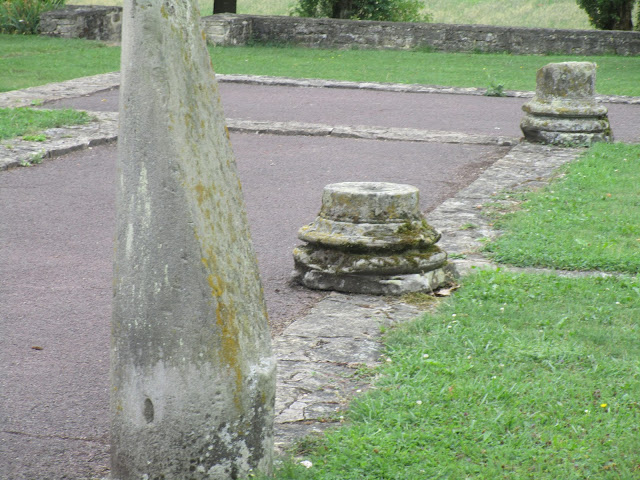Imagine you're a 19th-century farmer in western Germany. You're plowing along on a hillside on your farm and begin scraping across a large, flat, hard surface beneath the topsoil. You get your shovel to investigate and discover a mosaic floor!
As it turns out, this farmer had begun to unearth the ruins of a 66-room Roman villa, complete with a complex system of baths, dating back about 2,000 years.
We were able to visit this site, the Roman Villa Otrang, a couple days ago. It's not far from where we've been staying, in western Germany. The ruins were all excavated years ago and some areas of it now have protective buildings over them. There's a lot of explanation provided in each, but it's all in German. Fortunately for us, a pamphlet does give some basic information in English.
 |
| The stone and concrete lines across the lawns were the foundations of the walls dividing the many rooms. |
 |
| A wine press |
 |
| Bells |
 |
| Some tools - - a sickle and an axe head |
 |
| . . . the head of a pick-axe head and a cultivator. |
 |
| Here's a model of what the villa might've looked like. |
The Roman baths were rather complex, with hot and cold baths and heated sitting areas. They had sub-floor heating, provided by a system of ducts and airspace beneath the floors.
 |
| The floor would sit on top of these little pillars, allowing heated air to fill the space and warm the floor. |
|
 |
| Part of a limestone trough, probably from one of the baths. | | |
|
|
The most stunning thing is the mosaic floors!
 |
| Some pillar bottoms . . . or maybe tops! |
Imagine the patience it took to piece this all together! Each square is about a half-inch. And the floors are perfectly smooth.
 |
| A heating duct (The patterned area in this picture is some hard plastic material laid out for people to walk on, to avoid traffic over the mosaic floors.) |
 |
| Part of a heating system. The illustration below helps to show how it all worked. |
 |
| Playing on the antiquities |
 |
| The original cinderblock! |
 |
| On the hillside over Camilla's shoulder, there stood a Roman temple, but there are no ruins to be seen now. |
 |
| Wildflowers growing between the remaining foundations of a porch. |
A fascinating place to try to envision life as it might have been, for the wealthy, at least, 2000 years ago!





































No comments:
Post a Comment